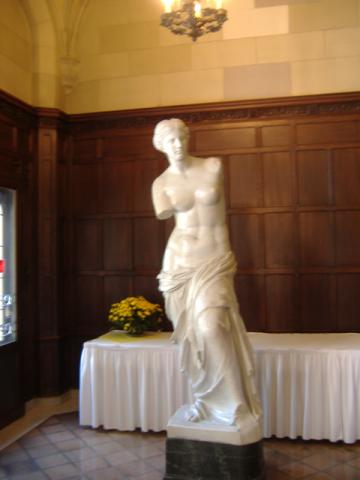By Debra Ball Johnson, ’80 ‘82
Photographs by the author
All of us Cookies, past and present, take Venus Down the Hall for granted. Standing ever vigilant, watching our mischievous activities in silence, she endures all the decorations and attires that over 90 years of students have imposed on her. William W. Cook complained about Martha Cook being “…cluttered with all sorts of jim-crack things,” as noted by Margaret A. Leary in her new book, Giving It All Away: The Story of William W. Cook & His Michigan Law Quadrangle. Venus, however, was anything but “jim-crack”, or even gimcrack. She is our goddess.
Both the Hayden Company, which furnished the Building, and the architects, York and Sawyer, were from New York City. A description of The Martha Cook Building’s architecture and furnishings was written by I. Elbert Scrantom, president of the Hayden Company. Mr. Scrantom notes that upon entering the building, one is confronted by a “long gallery”, with its high groined vaulted Gothic ceiling and high oak paneled walls of the Tudor period. “At the end of this gallery is the beautiful statue of Venus de Milo, a perfect replica of the original in the Louvre. “ It was carved in Italy from the finest statuary marble, and sent to Ann Arbor to be placed at the end of the “gallery”. He noted that the setting for the statue is similar to that of the Louvre, where the original is located.
At Martha Cook, Venus is first seen at a distance, the white marble in stark contrast to the dark paneling behind her. The light from the adjoining windows overlooking our garden glean on the highly polished Carrara marble. Posed on a pedestal, she floats above the crowds of women awaiting entry into the dining facilities. In the Louvre, the original Venus is also originally viewed from a distance down a long gallery. Illuminated by natural daylight from the windows to her right, she floats above the adoring crowds at the Louvre, second only in popularity to the Mona Lisa, in the author’s opinion.

Venus down the hall in Louvre, Paris
How did this Greek gal end up calling France her home? According to Gregory Curtis in his book Disarmed: The Story of the Venus De Milo,the statue was discovered by Olivier Voutier on the island of Melos in 1820. The French negotiated the purchase of the statue from the local government, a group of three men known as primates. Venus then took a leisurely five month cruise around the Aegean islands, finally arriving in Paris in 1821.
She was welcomed in France with open arms. Ironic, isn’t it? According to Mr. Curtis, the French were having Greek Statue Envy. The Apollo Belvedere, taken from the Vatican by Napoleon during a military campaign in 1796, was removed from Paris and returned to the Vatican in 1815. England had purchased the Elgin Marbles, the high-relief statues taken from the Parthenon, in 1816. The acquisition of Venus put France back in the forefront of owning Classical Greek sculpture as significant as its rival nations.
Venus de Milo, symbolizing feminine beauty and culture, is an integral part of the Martha Cook experience. She is decorated out of love, and has even been immortalized on an MCB t-shirt! We have Mr. Cook to thank for his foresight in furnishing our Building with beautiful things, to inspire our daily lives and memories.

